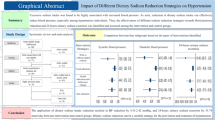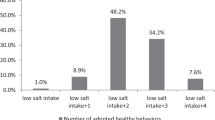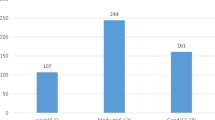Abstract
The study aimed to evaluate the reliability and the validity of the dietary sodium restriction questionnaire (DSRQ) in patients with hypertension receiving outpatient treatment at a tertiary care university hospital in Southern Brazil. This instrument is composed of three subscales: attitude, subjective norm and perceived behavioral control. A total of 104 patients were included. They were 63.3±8.9 years old and 75% were females. Cronbach’s alpha coefficient for the subscales of attitude, subjective norm and perceived behavioral control were 0.75, 0.37 and 0.82, respectively. The PCA with the extraction of three factors explained a total of 53.5% of the variance. The data suggest that the 15-item DSRQ is reliable and has internal consistency of its construct to measure the barriers and the attitudes of hypertensive patients related to dietary sodium restriction and may be useful to improve blood pressure control.
This is a preview of subscription content, access via your institution
Access options
Subscribe to this journal
Receive 12 print issues and online access
$259.00 per year
only $21.58 per issue
Buy this article
- Purchase on Springer Link
- Instant access to full article PDF
Prices may be subject to local taxes which are calculated during checkout
Similar content being viewed by others
References
Elliott P, Stamler J, Nichols R, Dyer AR, Stamler R, Kesteloot H et al. Intersalt revisited: further analyses of 24 hour sodium excretion and blood pressure within and across populations. Intersalt Cooperative Research Group. BMJ 1996; 312: 1249–1253.
He FJ, Li J, MacGregor GA . Effect of longer term modest salt reduction on blood pressure: Cochrane systematic review and meta-analysis of randomized trials. Brit Med J 2013; 346: f1325.
Riegel G, Moreira LB, Fuchs SC, Gus M, Nunes G, Correa Jr V et al. Long term effectiveness of non-drug recommendations to treat hypertension in a clinical setting. Am J Hypertens 2012; 25: 1202–1208.
Ajani UA, Dunbar SB, Ford ES, Mokdad AH, Mensah GA . Sodium intake among people with normal and high blood pressure. Am J Prev Med 29: 63–67.
Reinivuo H, Valsta LM, Laatikainen T, Tuomilehto J, Pietinen P . Sodium in the Finnish diet: II trends in dietary sodium intake and comparison between intake and 24- h excretion of sodium. Eur J Clin Nutr 2006; 60: 1160–1167.
Ferreira-Sae MS, Gallani MBJ, Nadruz WJ, Rodrigues RC, Franchini KG, Cabral PC et al. Reliability and validity of a semi-quantitative FFQ for sodium intake in low-income and low-literacy Brazilian hypertensive subjects. Public Health Nutr 2009; 12: 2168–2173.
Cornélio ME, Gallani MCBJ, Godin G, Rodrigues RCM, Mendes RDR, Nadruz Junior W . Development and reliability of an instrument to measure psychosocial determinants of salt consumption among hypertensive patients. Rev Lat Am Enfermagem 2009; 17: 701–707.
Polonia J, Martins L . A comprehensive review on salt and health and current experience of worldwide salt reduction programmers. J Hum Hypertens 2009; 23: 771–772.
Rodrigues MP . Avaliação da associação de consumo de feijão com arroz e pressão arterial em indivíduos hipertensos em tratamento. Master’s thesis UFRGS - Universidade Federal do Rio grande do Sul, 2014: http://www.lume.ufrgs.br/handle/10183/127383.
Lichtenstein HA, Appel LJ, Brands M, Carnethon M, Daniels S, Franch HA et al. Diet and lifestyle recommendations revision 2006: a scientific statement from the American heart association nutrition committee. Circulation 2006; 114: 82–96.
Appel LJ, Frohlich ED, Hall JE, Pearson TA, Sacco RL, Seals DR et al. The importance of population-wide sodium reduction as a means to prevent cardiovascular disease and stroke: a call to action from the American Heart Association. Circulation 2011; 123: 1138–1143.
Bentley B, Lennie TA, Biddle M, Chung ML, Moser DK . Demonstration of psychometric soundness of the Dietary Sodium Restriction questionnaire in patients with heart failure. Heart Lung 2009; 38: 121–128.
Montano DE, Kasprzyk D, Taplin SH . The theory of reasoned action and the theory of planned behavior Glanz K, Lewis FM, Rimer BK (eds). Health Behavior and Health Education. Theory, Research and Practice. Jossey-Bass: San Francisco, CA, 1997; 85–112.
d'Almeida KSM, Souza GC, Rabelo ER . Cross-cultural adaptation into Brazilian portuguese of the Dietary Sodium Restriction Questionnaire (DSRQ). Arq Bras Cardiol 2012; 98: 70–75.
d'Almeida KSM, Souza GC, Rabelo ER . Validity and reliability of the Dietary Sodium Restriction Questionnaire (DSRQ). Nur Hosp 2013; 28: 1702–1709.
Author information
Authors and Affiliations
Corresponding author
Ethics declarations
Competing interests
The authors declare no conflict of interest.
Supplementary information
Rights and permissions
About this article
Cite this article
Rodrigues, M., Rabelo-Silva, E., Fuchs, F. et al. Validity and reliability of the dietary sodium restriction questionnaire in patients with hypertension. Eur J Clin Nutr 71, 552–554 (2017). https://doi.org/10.1038/ejcn.2016.238
Received:
Revised:
Accepted:
Published:
Issue Date:
DOI: https://doi.org/10.1038/ejcn.2016.238
This article is cited by
-
Development of a short-form Chinese health literacy scale for low salt consumption (CHLSalt-22) and its validation among hypertensive patients
BMC Nutrition (2022)
-
Effect of motivational interviewing in hypertensive patients (MIdNIgHT): study protocol for a randomized controlled trial
Trials (2019)
-
The effectiveness of an educational intervention for sodium restriction in patients with hypertension: study protocol for a randomized controlled trial
Trials (2017)



